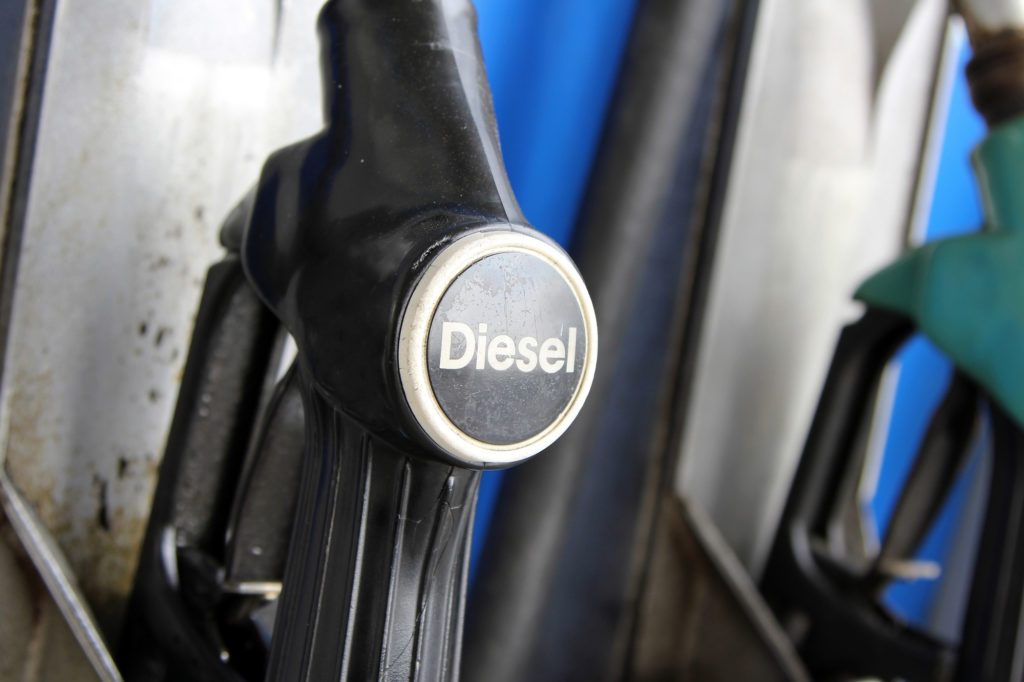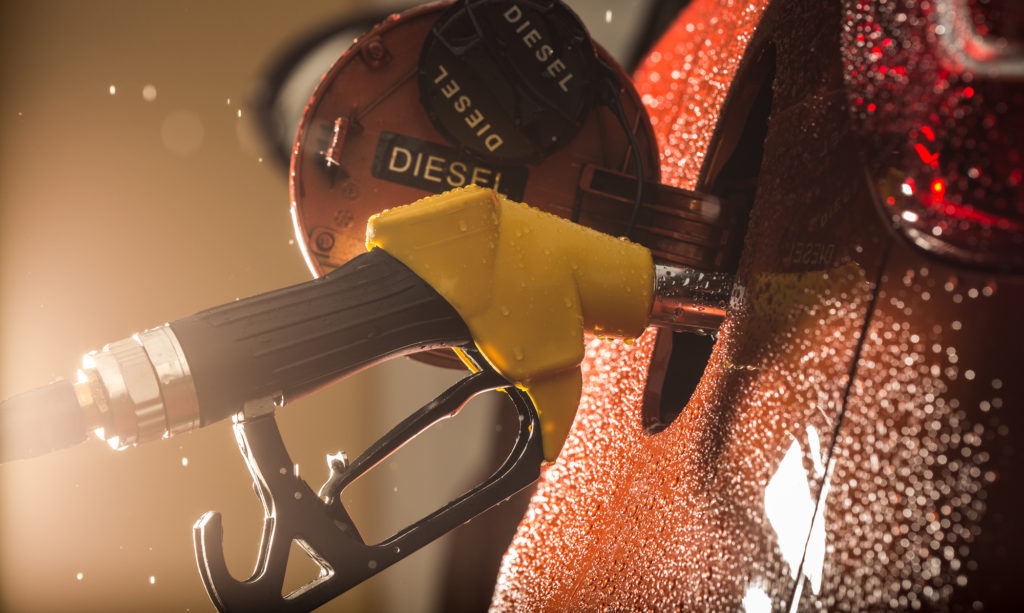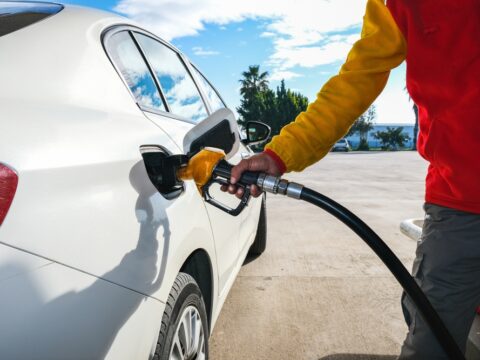Water in your diesel fuel tank can cause damage to fuel injectors, fuel pump, and fuel filter components, and you will want to take immediate action.
We will discuss how to identify water in a diesel fuel tank and methods for removing water yourself to help avoid any severe damage to your vehicle.

Contents
What Causes Water To Get Into The Fuel Tank?
Water enters diesel fuel tanks in several ways, including at the fill-up station and from condensation, which can be caused due to changes in the weather, including cooler temperatures. We have listed a few of the tank, and fuel line causes below.
Cause 1
Contamination
If the fuel you are using hasn’t been blended correctly, this can cause the gas additives to become contaminated. Aside from making the additives fruitless when it comes to ridding the fuel of unwanted deposits, the fueling system will also showcase varnish elements.
Another reason for contamination? Rainwater can enter the fuel if your gas cap or fuel filter is out of action. It is always important to access your diesel tanks for damage before filling up.
The final reason for contamination? Your gas station could be to blame. Certain unethical establishments lie about the octane rating of their fuel.
If it’s even a few points lower, this could have a detrimental effect on your diesel fuel tank, meaning your fuel storage tanks are privy to contaminants such as water, corrosion, and dirt – three things you don’t want in your fuel tank.
Even quality filtration systems can get this wrong, so it is always wise to double-check for water or contamination, which will showcase a water fuel mixture as opposed to pure diesel.
Cause 2
Rust in the gas tank
If rust is present in your fuel tank, you will need to inspect the fuel tank in its entirety, which means removing the entire thing.
This is often an issue with older machines, especially those equipped with steel gas tanks, which are extremely rusted prone when they come into contact with water.
If the rust is extremely bad, it may be better to replace the tank instead of attempting to clean it, as this is both time-consuming and often ineffective. Signs your tank is suffering from rust will be present on the fuel filler neck.
Cause 3
This symptom is often confused for a fuel filter that is clogged up or a motor that has been poorly tuned. Burning air, fuel, and water have the effect of drastically lowering the output of engine power.
To try and combat this issue, the ECU will inject more fuel into the system. This hurts your fuel tank and fuel economy as a whole.
Cause 4
Changes in the weather
Diesel fuel tanks can be attacked water condensation due to the fact they boast zero vapor pressure, which means they can’t displace air. Gasoline tanks, on the other hand, don’t suffer from this issue.
When a diesel fuel tank becomes hot, the air is forced to leave the tank as it expands. As night falls, the tank becomes cooler, and the air that is humid is sucked back into the tank. This causes condensation, which can add water to the fuel. This is why many choose to ensure their diesel fuel tanks are topped off.
What Does The Water In Diesel Fuel Look Like?
It is recommended you test the fuel for water. If your fuel appears a little on the cloudy side, water is present in the tank.
Other indications include erratic idling and rough starting, as well as black or even white smoke from the exhaust, which are indicators of water. In the worst-case scenario, your engine may cut out in entirety, especially when you try to accelerate.
The spluttering and idling issues are mainly down to the fact water is not flammable. When water finds its way into the combustion chamber, your tank will behave erratically.
Your tank is pretty good at notifying you of when this issue is occurring and will begin to splutter or showcase a lower performance than usual. If your vehicle was running efficiently until you stopped for a refuel, these symptoms are likely due to water in your tank. Other components to check include engine lights and your spark plugs.
A sudden surge or decrease in power is often the result of a combination of water and diesel fuel. The engine will experience a loss in power as it will find it challenging to compress the water. This will result in a power decrease.
When clean fuel enters this system or fuel injectors, this has the opposite effect, and the vehicle will likely surge forward.

How Much Water In A Diesel Tank Is Bad?
The US Federal Diesel Fuel and EN590 Guidelines have numerous standards, with water contamination being the most problematic for a diesel fuel storage system.
In terms of how much water in the diesel fuel tank is considered bad, the max is 200 PPM. Per kilogram of diesel fuel equates to 200mg of water in the fuel system.
How To Get Water Out Of A Diesel Fuel Tank
To remove water from your diesel fuel tank, you will likely need to pump or drain your fuel system, being sure to get rid of as much water as possible from the diesel fuel tank.
It is important to invest in a siphon hose, which boasts a length that allows you to touch the base of the diesel fuel tank. You will need to add the correct sum of Diesel 911 (or another diesel fuel additive) to your diesel fuel tank.
Method 1: Manual Bleeding
This method is one of the most popular, especially as it is a hassle-free way to remove water from diesel tank equipment.
It involves siphoning out contaminated water-fuel using a handy siphon kit, as well as a hand pump.
Tools and equipment needed
You will need a siphon kit, a hand pump, and a hose that is lengthy enough to touch the tank walls and base, as well as an additive.
Step 1
Drain addition contaminated diesel-water fuel by removing the fuel filter.
Step 2
Fill fuel filters with a mixture of 50% additive and 50% diesel fuel.
Step 3
Re-attach the fuel filters and placing back on your car.
Step 4
Start your Diesel engine (or Diesel engines if assisting more than one car) up.
Method 2: Using an additive
This is another effective way to action water and fuel separation and can be applied to both traditional and underground fuel storage tanks.
This method uses a methanol base to assist in diluting the water, which removes it from the fuel mixture. This method is only really suited to those wishing to rid storage tanks of small traces of water.
Tools and equipment needed
All that is required is a quality fuel tank additive. For best results, try to complete this in the winter months, as this will prevent clogging filters from occurring in the summer months.
Step 1
Begin by removing the fuel filter, as this will aid in draining additional diesel fuel from the tank if it has been contaminated.
Step 2
Read the back of the additive label to ensure you have the right quantity per fuel tank size.
Step 3
Add addictive.
Step 4
You can turn your engine on immediately as the addictive will still take effect as you drive and as the diesel cools, making its way into the filtration system, ridding the tank or diesel storage systems of any excess water.
Effects Of Water In A Diesel Fuel Tank
Water can cause both iron and steel components to become rusty, which in turn means a loose iron oxide particles will be released into the diesel fuel tank. These exact particles can clog fuel filters in a speedy manner.
Those sized like microns may even pass through the fuel filters, meeting the likes of fuel injectors along the way, damaging fuel injection sprays by scoring the surfaces of the diesel fuel tank.
Best Additive To Remove Water From A Diesel Tank
Heet is the most popular additives used on diesel fuel tanks today, especially for those looking to rid their diesel engine of water.
As well as being a gas anti-freeze, ISO-HEET fuel additives can remove almost five times the amount of water from your diesel engine fuel system as other fuel water separators have claimed to do.
It is extremely easy to use and can apply to both a diesel fuel tank and gas engines.














